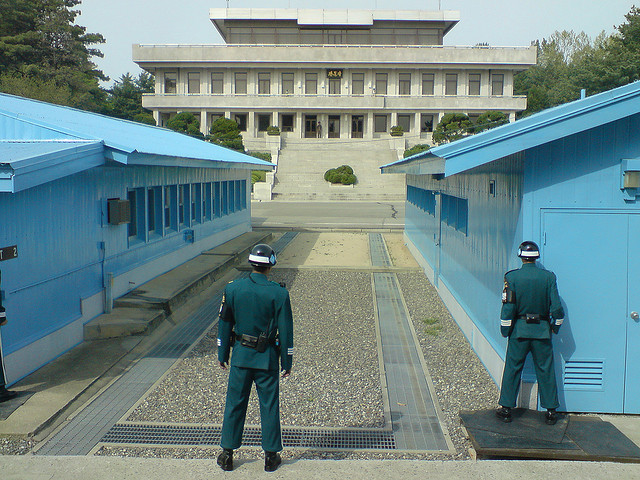
After the UN Security Council tightened existing sanctions against North Korea this month (adding four organisations and six individuals to its blacklist) the North responded by warning that it would carry out additional rocket launches and a third nuclear test. In recent days, the North has ramped up its histrionic rhetoric saying that a third nuclear test is the ‘demand of the people’ and that it has ‘no other option but to push forward towards the final showdown’.
Against this backdrop, there’s no doubt that we’re in the middle of another cycle of North Korean nuclear brinkmanship. Intelligence reports, including images of activity around the Punggye-ri nuclear test site, suggest that a third nuclear weapon test is imminent—another step in Pyongyang’s typical escalatory ladder. For instance, in April 2009 it began by conducting a rocket launch, which prompted the UNSC to tighten sanctions. This led Kim Jong-Il to retaliate by authorising a second nuclear test. It wouldn’t be surprising to see the same pattern repeated, especially in the context of the North’s current threat levels, South Korea’s successful rocket launch, and because South Korea is due to assume the UNSC presidency in February.
Looking back, North Korea’s first nuclear test was widely considered to be a failure and its second too small to be an unqualified success. But analysts now fear that a third might produce a yield of between 12–20 kilotonnes, which would indicate that North Korea has managed to resolve some or all of its technical difficulties.
If there is a third successful test in the near future, we can expect the usual response from the international community. The unfortunate reality is that the North Korea nuclear challenge has developed into a seemingly unsolvable conundrum, and in the absence of any clear solution, the international community will respond much the same way as it has in the past—probably with the same results.
First, there’ll be the usual diplomatic outcry, as it will have become clear that Kim Jong-un has established his country as a fully-fledged nuclear power and proved that he’s just as willing as his father to engage in strategic brinkmanship. Following the initial outcry, the UNSC will roll out further condemnation, with another resolution tightening existing sanctions or—if a more far-reaching deal can be reached with China—new sanctions.
There’s also likely to be some soul-searching over what steps might have a chance of stabilising the increasingly volatile situation in Northeast Asia. Once the initial furore dies down, one option that might gain greater traction is a more concerted effort to engage North Korea in regional dialogue, possibly via a diplomatic process involving some or all of the countries that were involved in the Six Party Talks. (An initiative involving China, Japan, North Korea, Russia, South Korea, and the United States which ran from 2003–2008,and which led to some constructive dialogue and concrete progress in disarmament). At least initially, the aim of these talks would need to be less ambitious than the previous Six Party Framework; it could simply focus on opening channels of communication and de-escalating the current standoff.
This idea would inevitably attract support from China, which provided much of the momentum behind the Six Party Talks. Even so, getting a regional process off the ground wouldn’t be easy. In the clearest statement that it has made to date, North Korea’s foreign ministry claimed that the Six Party Talks and the joint September 19 statement are ‘null’ and the denuclearisation of the Korean peninsula has been ‘put to an end.’
But the Obama administration hasn’t shown any enthusiasm for the resumption of regional dialogue and, for any multilateral initiative to work, it will need the United States. At a 12 December press conference, US Ambassador to the UN, Susan Rice, stated that Pyongyang would have to ‘demonstrate clearly and without equivocation [its] commitment to denuclearization’ as a foundation for a ‘credible resumption’ of the Six-Party process. A rocket launch followed by a declaration of nuclear defiance (and possibly a nuclear test) hardly meets those criteria, and the understandable desire of the Obama administration is to avoid any initiative that could be interpreted as rewarding North Korea’s provocations.
However, it would be unwise to prolong the current isolation of North Korea (including from its only ally, China), which gives it little incentive to change its behaviour. Sanctions are a necessary and important part of the international community’s response to nuclear brinkmanship, but they need to be backed by other measures that facilitate dialogue and reduce tension. But what we have is a fragmented approach. The Obama administration’s policy of ‘strategic patience’ (waiting for Pyongyang to show a willingness to negotiate in good faith while relying on sanctions for damage limitation) is strong on principle but we need something more—particularly in the context of the growing instability in East Asia and the potential for conflict escalation. More than the UNSC efforts, we need pro-active diplomatic engagement, through coordinated bilateral and multilateral efforts among those with the greatest stakes in maintaining peace and stability in Northeast Asia. We also still lack a strong state to lead in Northeast Asia on non-proliferation and disarmament issues.
Australia’s role in all of this is relatively limited in comparison with the most significant players, China and the US. Australian diplomats in New York have contributed to the sanctions regime through last week’s unanimous vote in favour of tightening existing Security Council sanctions, and will no doubt support further sanctions in the event of a third North Korean nuclear test. However, Australia could use its diplomatic influence to engage Pyongyang bilaterally—a process that should be facilitated by the planned opening of a North Korean embassy in Canberra.
Tanya Ogilvie-White is a senior analyst and Hayley Channer is an analyst at ASPI. Image courtesy of Flickr user kalleboo.

